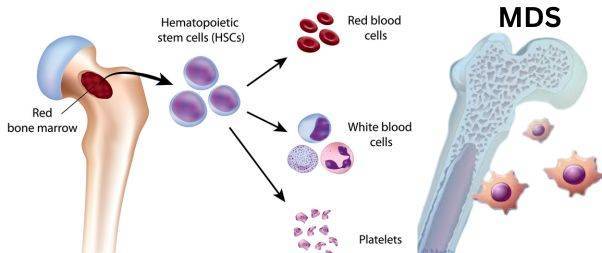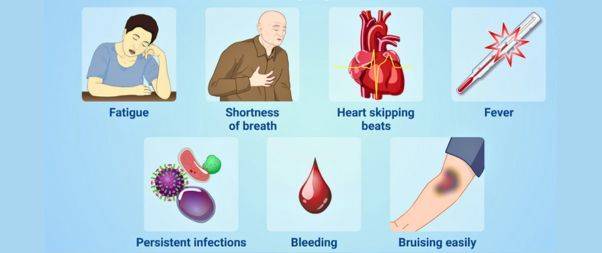Norm Macdonald, a beloved comedian and actor known for his dry wit and unique comedic style, passed away in September 2021 after a long and private battle with cancer.
Macdonald was a prominent figure in the world of comedy, known for his time on “Saturday Night Live“ and his own show, “Norm Macdonald Has a Show.“
His death was a significant loss to the comedy world, and it brought attention to the type of cancer he had –Myelodysplastic syndromes or Myelodysplasia(MDS).
What is Myelodysplasia(MDS)?

Myelodysplastic syndromes are a type of cancer where the young blood cells in the bone marrow don’t grow up to become healthy blood cells, leading to low blood cell counts, or cytopenias.
They don’t turn into mature red blood cells, white blood cells, or platelets like they should.
Usually, the soft stuff inside your bones (called bone marrow) makes:
- Red blood cells that carry oxygen all over your body
- White blood cells that help fight off infections
- Platelets that help your blood stick together and clot
It is a group of disorders caused by poorly formed blood cells or cells that do not work properly.
When there aren’t enough healthy blood cells, problems like infections, tiredness from lack of red blood cells (anemia), or easy bruising and bleeding can happen.
People with MDS often have a high number of immature cells (blast cells) in their blood, but less than 20%.
Types of MDS
Different types of myelodysplastic syndromes are identified based on specific changes in blood cells and bone marrow.
Refractory Anemia: This type is diagnosed when there aren’t enough red blood cells in the blood, causing anemia. However, the number of white blood cells and platelets is normal.
Refractory Anemia with Ring Sideroblasts: Here, there aren’t enough red blood cells in the blood. The red blood cells have too much iron inside them. The number of white blood cells and platelets is normal.
Refractory Anemia with Excess Blasts: In this type, there aren’t enough red blood cells in the blood. Between 5% to 19% of the cells in the bone marrow are blasts (immature cells). There may also be changes to the white blood cells and platelets. This type can turn into acute myeloid leukemia (AML).
Refractory Cytopenia with Multilineage Dysplasia: This type is diagnosed when there are too few of at least two types of blood cells (red blood cells, platelets, or white blood cells). Less than 5% of the cells in the bone marrow are blasts and less than 1% of the cells in the blood are blasts. If red blood cells are affected, they may have extra iron. This type can also turn into AML.
Refractory Cytopenia with Unilineage Dysplasia: This type is diagnosed when there are too few of one type of blood cell (red blood cells, platelets, or white blood cells). There are changes in 10% or more of two other types of blood cells. Less than 5% of the cells in the bone marrow are blasts and less than 1% of the cells in the blood are blasts.
Unclassifiable Myelodysplastic Syndrome: This type is diagnosed when the numbers of blasts in the bone marrow and blood are normal, and the disease is not one of the other myelodysplastic syndromes.
Myelodysplastic Syndrome Associated with an Isolated del(5q) Chromosome Abnormality: This type is diagnosed when there aren’t enough red blood cells in the blood, causing anemia. Less than 5% of the cells in the bone marrow and blood are blasts. There is a specific change in the chromosome.
Chronic Myelomonocytic Leukemia (CMML): For more information, see Myelodysplastic/Myeloproliferative Neoplasms Treatment.
Signs and Symptoms

Often, MDS don’t show any early signs or symptoms. They might be discovered during a regular blood test.
The signs and symptoms could be due to MDS or other health issues.
You should talk to your doctor if you notice any of the following:
- Feeling out of breath
- Feeling weak or tired more than usual
- Skin looking paler than it normally does
- Bruising or bleeding easily
- Tiny, flat red spots under the skin from bleeding (known as petechiae)
Chance of Turning into Leukemia
Some people with MDS might later get Acute myeloid leukemia (AML), a cancer of the white blood cells.
This change is called “transformation”. It can happen in a few months or it might take several years.
Whether this happens depends on the type of MDS you have and how many normal and abnormal blood cells you have.
You should talk to your doctor about your chance of getting AML.
Diagnosis
To diagnose MDS, doctors do
- Blood tests
- Bone marrow tests
The blood tests can show how many normal and abnormal blood cells you have.
For a bone marrow test, a doctor takes a small sample of your bone marrow, usually from your hip bone. This is done using a needle and local anesthetic to numb the area.
The doctor puts the needle through your skin and into your bone to pull out some bone marrow into a syringe. This sample is then sent to a lab to be looked at under a microscope.
The bone marrow test takes about 15 to 20 minutes and can be done in the hospital ward or in the outpatient department.
You can learn more about bone marrow tests on the Cancer Research UK website.
How MDS is Treated
The treatment you receive will depend on the type of MDS you have, your chance of getting AML, and if you have any other health problems.
The goal of treatment is to get the number and type of blood cells in your bloodstream back to normal and to manage your symptoms.
If your MDS has a low chance of turning into cancer, you might not need treatment right away. Instead, you might just have regular blood tests to monitor your condition.
Supportive Treatment
MDS symptoms can often be managed with a mix of the following treatments:
- Injections of growth factor medicines, like erythropoietin or G-CSF, to increase the number of healthy red or white blood cells
- A blood transfusion of either red blood cells or platelets, depending on what you need
- Medicine to get rid of extra iron in your blood, which can build up after many blood transfusions
- Antibiotics to treat infections, if your white blood cell count is low
Lenalidomide
The medicine lenalidomide can be used to treat a rare type of MDS called deletion 5q, or del(5q).
People with del(5q) can have severe anemia (a lack of red blood cells), which requires regular blood transfusions.
Lenalidomide is a type of treatment known as a biological therapy. It’s taken as a capsule and affects how your immune system works.
Azacitidine
Azacitidine is a type of medicine known as a hypomethylating agent, which is injected under the skin.
It’s sometimes given to people with more serious types of MDS, and may improve blood production and slow down the progress of MDS.
Chemotherapy
Chemotherapy is sometimes given if you have a type of MDS that increases your risk of AML.
It involves taking medicines that destroy the immature blood cells by stopping them from growing. It’s taken either as a tablet or an injection.
Your chemotherapy treatment will probably be similar to that used for AML.
Find out more about how AML is treated
Immunosuppressants
Immunosuppressant medicines, such as anti-thymocyte globulins (ATGs) and ciclosporin, can be used to suppress the immune system and can sometimes help improve blood count.
Stem Cell (Bone Marrow) Transplant
A stem cell transplant (also called a bone marrow transplant) is given after chemotherapy.
It involves replacing your abnormal blood cells with healthy cells from a donor. The healthy blood cells are put into your bloodstream through a drip.
It can sometimes cure MDS, but isn’t suitable for everyone.
A stem cell transplant will generally only be offered if you’re young and otherwise in reasonably good health, as it’s a very intensive treatment.
It helps if you have a suitable donor in your family (a close relative, like a brother or sister). But it’s sometimes possible to have a stem cell transplant using an unrelated donor whose tissue type closely matches yours.
Living With MDS: Norm Macdonald’s Final Stand-Up Special

On June 28, 2020, comedian Norm Macdonald decided to film a comedy special the night before his scheduled stem cell transplant.
His cancer, which had been in remission for 7 years, had returned. Lori Jo Hoekstra, his best friend and long-time producing partner, helped him film the special in her condo.
Macdonald delivered his material for 54 minutes without stopping.
Macdonald, who passed away in September 2021, kept his illness a secret, only telling Hoekstra, his manager Marc Gurvitz, and his immediate family.
He believed that revealing his illness would affect his comedy career. Despite his health struggles, he remained focused on his comedy, even managing to perform almost an hour of material without notes the night before his transplant.
The special, named “Nothing Special,” begins streaming on Netflix on Monday. It includes footage of friends and fans discussing the comedian after watching his final work together.
Despite his passing, Macdonald’s dedication to his craft and unique comedic style continue to resonate with audiences.
In a Nutshell
Macdonald’s experience as a cancer survivor emphasizes the crucial role of battling cancer with resilience and highlights the value of early detection in enhancing life quality for those living with the disease.
His story underscores the importance of being in tune with your body and being alert to any changes.
This serves as a reminder for all of us to stay knowledgeable about our health and to be proactive in seeking medical care if we observe any alterations.
Remember to Look After Yourself!
Also Read






